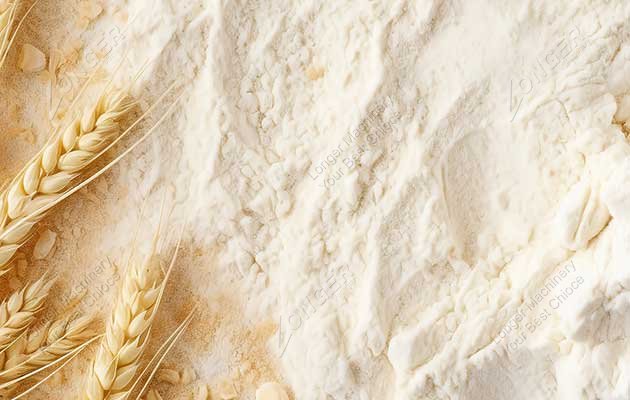What Is The Process of Flour Packaging?
Publish:2025-08-11 By Sherry
As a daily necessity, flour must undergo a scientific and rigorous packaging process before entering the market to ensure product quality, accurate weight, and safe transportation and storage. So, what is the process of flour packaging? The flour packaging process generally includes steps such as weighing, bagging, and sealing. However, the specific packaging process and equipment configuration may vary depending on the package size (such as 1kg, 5kg, 25kg, etc.).
1. Weighing
Weighing is the first step in flour packaging, ensuring that each bag meets the standard weight.
Small-sized packages (e.g., 1-5 kg) typically utilize an automatic quantitative packaging machine combined with an electronic scale system for high-speed, accurate weighing.
Large-sized packages (e.g., 25-50 kg) typically utilize a gravity or screw-type weighing system, allowing for a larger material flow rate. Pneumatic gates are also used to adjust the speed and ensure accuracy.

2. Bagging
After weighing, the flour enters the bagging stage.
Automated bagging: In large-scale production, packaging machines automatically fill the flour into pre-made bags.
Manually assisted bagging: Some small and medium-sized factories still manually align the bag opening with the feed opening and initiate filling during the bulk packaging process.
The bag materials are typically plastic composite bags, kraft paper bags, or woven bags, depending on the mode of transportation, moisture-proofing requirements, and market positioning.
3. Sealing
Sealing is crucial for preventing flour from getting wet and leaking.
Heat sealing: Applicable to plastic or composite bags, a heat sealer heats and fuses the bag openings.
Sewing: Applicable to woven or kraft paper bags, a sewing machine overlocks the edges.
Heat sealing + sewing: Some flour for export or long-distance transportation uses a double sealing method to enhance sealing and protection.
4. Inspection and Labeling
After sealing, the package is typically inspected by a metal detector and weighed to ensure it is free of foreign matter and within acceptable weight tolerances. A label or inkjet printer is then applied, including the production date, batch number, weight, and manufacturer information.
5. Boxing and Palletizing
Small packages of flour are first packed into cartons and then neatly stacked onto pallets by an automatic palletizer. Large packages of flour are directly palletized for easy forklift handling.
Issues to Note During Flour Packaging:
Moisture-Proofing: Flour easily absorbs moisture and clumps, so packaging materials must be moisture-proof and humidity in the production environment must be controlled.
Dust-Proofing: Flour contains a lot of fine powder, so dust removal equipment is required at the packaging site to reduce dust pollution and safety risks.
Weighing Accuracy: Inadequate weighing not only affects sales but may also violate regulations.
Bag opening security: Prevent bag breakage and powder leakage during transport, especially in large packages.
Food safety: The flour packaging machine's contact areas with the flour must be made of food-grade stainless steel and regularly cleaned and disinfected.
1. Weighing
Weighing is the first step in flour packaging, ensuring that each bag meets the standard weight.
Small-sized packages (e.g., 1-5 kg) typically utilize an automatic quantitative packaging machine combined with an electronic scale system for high-speed, accurate weighing.
Large-sized packages (e.g., 25-50 kg) typically utilize a gravity or screw-type weighing system, allowing for a larger material flow rate. Pneumatic gates are also used to adjust the speed and ensure accuracy.

2. Bagging
After weighing, the flour enters the bagging stage.
Automated bagging: In large-scale production, packaging machines automatically fill the flour into pre-made bags.
Manually assisted bagging: Some small and medium-sized factories still manually align the bag opening with the feed opening and initiate filling during the bulk packaging process.
The bag materials are typically plastic composite bags, kraft paper bags, or woven bags, depending on the mode of transportation, moisture-proofing requirements, and market positioning.
3. Sealing
Sealing is crucial for preventing flour from getting wet and leaking.
Heat sealing: Applicable to plastic or composite bags, a heat sealer heats and fuses the bag openings.
Sewing: Applicable to woven or kraft paper bags, a sewing machine overlocks the edges.
Heat sealing + sewing: Some flour for export or long-distance transportation uses a double sealing method to enhance sealing and protection.
4. Inspection and Labeling
After sealing, the package is typically inspected by a metal detector and weighed to ensure it is free of foreign matter and within acceptable weight tolerances. A label or inkjet printer is then applied, including the production date, batch number, weight, and manufacturer information.
5. Boxing and Palletizing
Small packages of flour are first packed into cartons and then neatly stacked onto pallets by an automatic palletizer. Large packages of flour are directly palletized for easy forklift handling.
Issues to Note During Flour Packaging:
Moisture-Proofing: Flour easily absorbs moisture and clumps, so packaging materials must be moisture-proof and humidity in the production environment must be controlled.
Dust-Proofing: Flour contains a lot of fine powder, so dust removal equipment is required at the packaging site to reduce dust pollution and safety risks.
Weighing Accuracy: Inadequate weighing not only affects sales but may also violate regulations.
Bag opening security: Prevent bag breakage and powder leakage during transport, especially in large packages.
Food safety: The flour packaging machine's contact areas with the flour must be made of food-grade stainless steel and regularly cleaned and disinfected.
- Pre: Tomato Ketchup Pouch Packing Machine Cost
- Next: None

 Products
Products 
 Message
Message